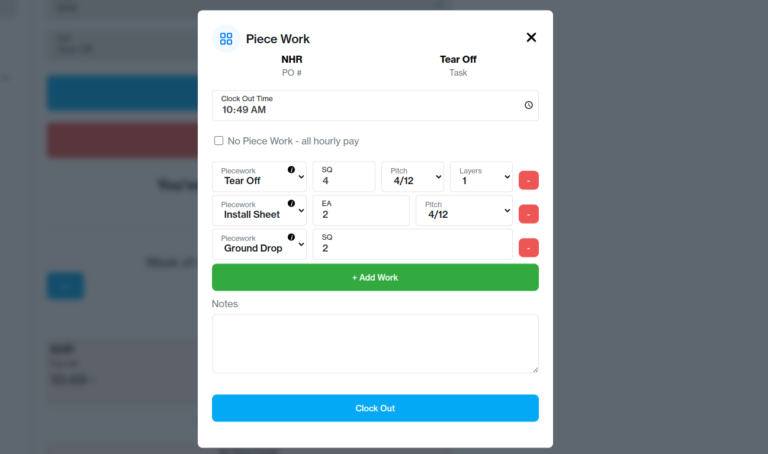Overcoming Common Objections to Piece Rate in the Roofing Industry
Table of Contents
- Introduction
- “It’s Not Fair to Pay by the Piece”
- “Quality Will Go Down If We Pay by the Piece”
- “Tracking Piece Work Is Too Complicated”
- “Workers Won’t Like the Change”
- “Approving Payroll and Running Reports Takes Too Much Time”
- “We Might Run Into Labor Law Issues”
- Why Piece Rate Works
- Parting Thoughts
1. Introduction
Paying by the hour is common in the roofing industry, but it can leave high-performing workers feeling under-rewarded and create inefficiencies on the job site. Over time, many roofing businesses look for a better way to match pay with performance. That’s where piece rate comes in.
Piece rate means paying for the actual amount of completed work—like the number of shingles installed or the square footage covered—instead of strictly by the hour. This approach can incentivize workers to stay focused and work efficiently. However, piece rate can also raise questions and concerns. Many roofing business owners worry about fairness, quality, tracking, and how to handle payroll.
This article looks at the most common objections to piece rate in the roofing industry and explains how to address each one. These lessons come from real experience in the field: a roofing business owner who saw these concerns firsthand and worked through them to develop a software tool that tracks piece work. Although piece rate may require new systems and open communication, it can boost productivity, morale, and profits when done well.
2. “It’s Not Fair to Pay by the Piece”
The first worry often heard about piece rate is that it feels unfair. Some crew members might pick up simpler tasks, while others end up with more challenging or time-consuming work. Meanwhile, experienced roofers could earn a higher rate, which may leave newer workers feeling discouraged.
How to Address the Fairness Issue
- Define Clear Rates
Clearly outline how much is paid per shingle, per square, or per specific task. Everyone on the crew should know the rules from day one. This transparency helps avoid confusion or suspicion that certain workers get favored. - Rotate Complex Tasks
If certain tasks—like detailed flashing work—are tougher or take longer, rotate them among the crew. That way, no one person is always stuck with a more difficult job while others complete simpler tasks. - Encourage Mentorship
Pair new hires with experienced roofers so everyone can learn the best techniques and speed up over time. Instead of feeling discouraged, newer workers see a clear path to improving their skills and earning more.
Fairness is rarely a problem when expectations are clear and the crew rotates tasks appropriately. A balanced approach can lead to a highly motivated and well-trained team.
3. “Quality Will Go Down If We Pay by the Piece”
Some roofing business owners worry that paying by the piece encourages workers to rush, cutting corners to finish faster, which is a valid concern. Quality is crucial in roofing because any oversight—like loose shingles or poorly installed vents—can lead to leaks or damage down the road.
How to Maintain Quality Under Piece Rate
- Set Quality Standards
Establish clear guidelines on proper shingle placement, correct nailing techniques, and other quality metrics. Provide written or visual instructions. When the entire crew understands the standards, they can meet them more consistently. - Conduct Inspections
Perform regular spot checks to confirm quality. If a worker’s section fails inspection, it must be redone before the day is over and they won’t get paid twice for the same work. This makes it clear that rushing won’t be rewarded if the work isn’t done right. You can also have your crews take pictures of their work to self document and show their quality. - Link Pay to Quality
Consider tying pay rates to successful installations. If repairs are needed because of negligence or poor workmanship, reduce future piece rate payments for that individual or require them to fix it without extra pay. This shows that consistent quality goes hand-in-hand with earning more.
By establishing a structure that rewards both speed and accuracy, it’s possible to maintain high standards without sacrificing productivity. Workers soon realize that quality lapses will only create more work and reduce their overall pay.
4. “Tracking Piece Work Is Too Complicated”
Switching from hourly pay to piece rate can feel overwhelming when it comes to record-keeping. Roofing tasks vary, and crew sizes can change from job to job. Many worry that it will take too much time to verify each piece or each completed square.
How to Simplify Piece Work Tracking
- Use Technology
Modern software tools (like Piece Work Pro) streamline the process. Crew members can clock in with a simple tap or click, then enter daily totals of shingles or squares installed. All calculations happen automatically in the background. - Check Daily Totals
Instead of waiting until the end of the week, verify each worker’s piece counts on a daily basis. This makes it easier to spot discrepancies early and ensures the final numbers are accurate. - Proper Enforcement
I love the saying “People don’t do what you expect, they do what you inspect” Part of any new system requires constant attention, especially when you’re first implementing it. While your crew is getting into the habit of using software, remind them consistently and quickly when they forget a step. Quick feedback will help everyone get in the habit as fast as possible.
With the right methods in place, tracking piece work becomes manageable instead of a headache. The key is to adopt a tool or process that fits a roofing crew’s day-to-day reality.
5. “Workers Won’t Like the Change”
Switching to piece rate can prompt concerns from employees. Those who’ve grown comfortable with hourly pay might fear they’ll earn less or be pushed to work faster than they can handle. In some cases, workers might resist any kind of change at all, simply because it’s unfamiliar.
How to Introduce Piece Rate to a Crew
- Explain the Benefits
Show crew members exactly how piece rate can help them earn more if they work efficiently. Share examples or run a small pilot project so they can see the difference in their paycheck for the same or even less total time spent on the job. - Start with a Test Run
Rather than switching everything overnight, consider trying piece rate on one or two jobs to see how it goes. This allows the crew to get used to the system and ask questions without feeling trapped in a new pay structure. - Address Concerns Promptly
Keep an open line of communication. If some employees worry about fairness or quality expectations, hold quick meetings or toolbox talks to address those points. Let them see there is a commitment to making sure the system benefits everyone.
Workers often find that once they get used to piece rate, they enjoy being rewarded for their skill and speed. Over time, many crews prefer a system that directly connects effort and pay.
6. “Approving Payroll and Running Reports Takes Too Much Time”
Hourly payroll typically involves collecting timesheets and multiplying hours by a pay rate. Piece rate can add a layer of complexity: each person will have different totals for installed squares and other specific tasks. It’s natural to worry that the extra data could make payroll a bigger chore.
How to Streamline Payroll with Piece Rate
- Automate Time Card Approvals
Choose a system where crew members clock in and out digitally. The tool can compile all the hours, plus the piece rate details, in one place. Approving time cards then becomes a matter of reviewing and clicking “approve,” rather than chasing down paper slips. - Use Automated Reports
A good piece work tracking solution can generate a payroll summary with a single click. You’ll see each employee’s total hours, total pieces, and final pay. This simplifies the calculation process and can cut payroll preparation time significantly. - Leverage Job Costing
Payroll reports can also feed into job costing data. By linking piece rate info to specific roofing projects, it’s possible to see exactly how much each job cost in labor. This insight helps with bidding future jobs and planning crew sizes more effectively.
When properly set up, a piece rate system doesn’t have to slow down the back office. In fact, many roofing businesses find that digital tools reduce paperwork and make payroll less stressful than before.
7. “We Might Run Into Labor Law Issues”
Legal compliance is a major concern for every roofing company. It’s important to ensure employees earn at least minimum wage, and that overtime is handled correctly. Not everyone is sure how piece rate fits into these requirements.
How to Comply with Labor Laws When Using Piece Rate
- Review Local and Federal Guidelines
Labor laws vary by region, so it’s important to research both local and national rules. Look for guidelines on minimum wage and overtime when using a piece rate system. Government websites often provide clear explanations for employers. - Track Hours and Pieces
Even if the crew is being paid by the piece, keep accurate records of their hours. If someone’s total piece rate pay for a certain period doesn’t meet the minimum wage standard, the employer may need to top it up. - Consult Professionals
If uncertainty remains, consider hiring an HR consultant or employment lawyer to review the piece rate setup. A small investment in legal advice can save major headaches or fines in the future.
By setting up a system that handles both hours and piece totals, roofing companies can comply with labor laws while enjoying the benefits of performance-based pay.
8. Why Piece Rate Works
Piece rate can help a roofing business reward hard work and skill. It often leads to crews that work more efficiently and with greater focus. Employees who finish tasks faster see a direct bump in earnings, which can boost morale and attract top talent. As long as quality standards are enforced, piece rate can enhance productivity without sacrificing workmanship.
Many roofing companies find that once they address common objections, their teams grow to prefer piece rate. Workers appreciate being paid more for working effectively, while business owners see projects completed more quickly and profitably. The key is having a reliable, user-friendly system to track pieces and pay, along with strong communication about expectations.
9. Parting Thoughts
Shifting to a piece rate model can feel like a big change, but the potential benefits for roofing companies are significant. Common objections usually revolve around fairness, quality, tracking, acceptance, payroll complexity, and legal compliance. Each of these challenges has been overcome in countless roofing businesses by implementing clear guidelines, using the right tools, and engaging in open dialogue with employees.
A well-designed piece rate system ensures that those who put in extra effort earn more, while also maintaining high quality standards. With accurate tracking of hours, pieces, and costs, it’s possible to streamline payroll and keep everything compliant with labor laws. When done thoughtfully, piece rate can motivate crews, reduce wasted time, and improve a company’s bottom line.
Ultimately, the move to piece rate is about paying smarter, not paying less. It sets up a system where crew members are rewarded fairly for the value they bring to each roofing project. By taking these objections seriously and addressing them head-on, roofing businesses can enjoy the advantages of a payment model that encourages productivity, keeps quality high, and sustains a healthy work environment.




